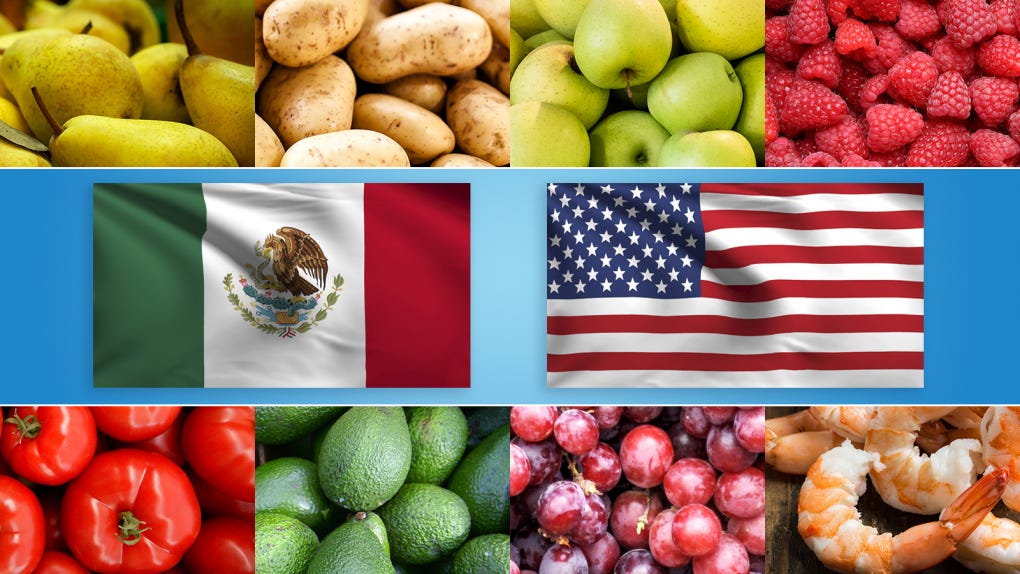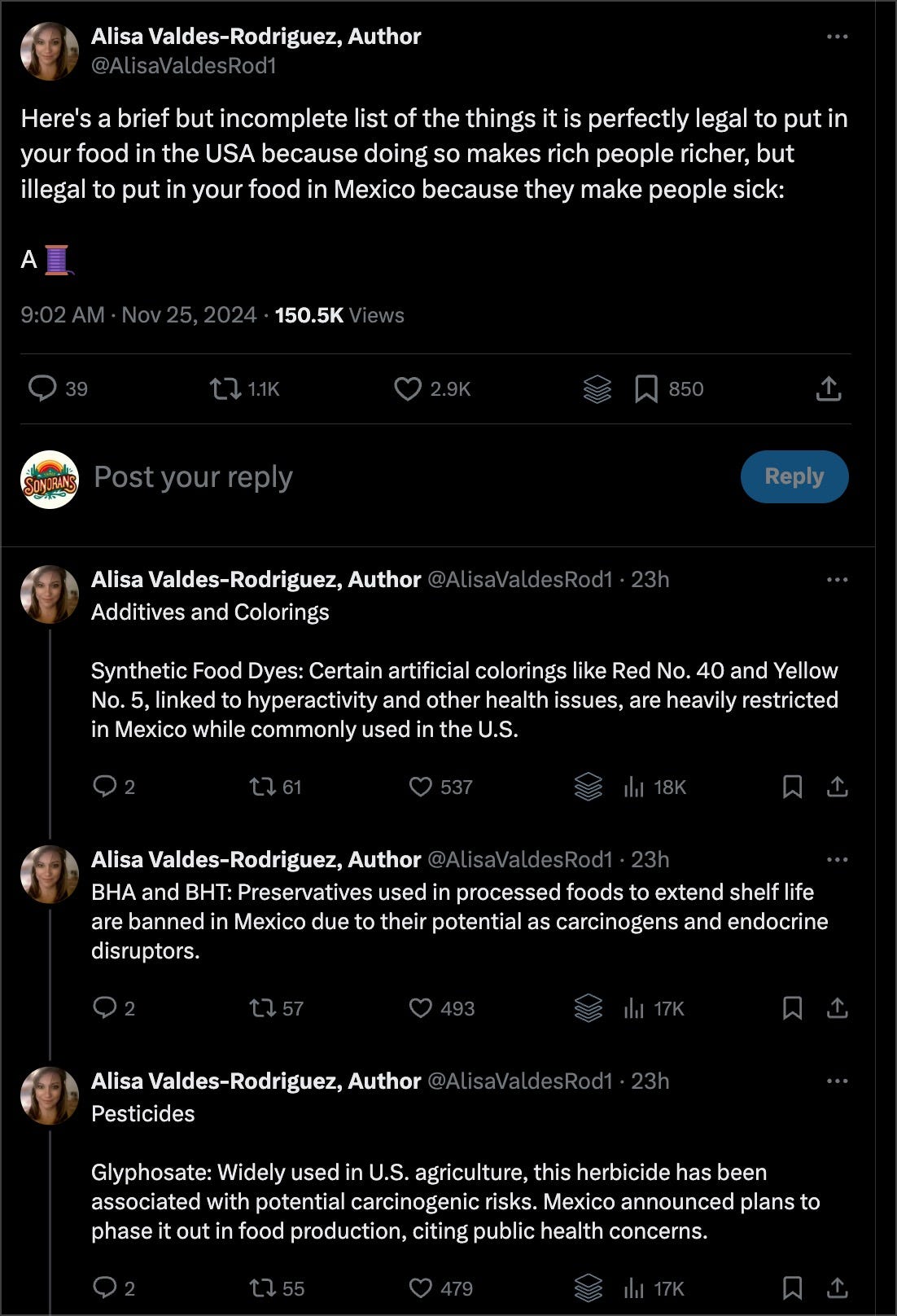🥗 Food Safety Face-Off: U.S. vs. Mexico
Discover the surprising differences in food regulations that affect what we eat every day! What is banned in Mexico but allowed in the U.S.?
😽 Keepin’ It Simple Summary for Younger Readers
👧🏾✊🏾👦🏾
🚨🍽️ Food safety is very important! 🌍 In the U.S., there are some ingredients in food that are legal 🚫🍔 even though they can be harmful, while in Mexico 🇲🇽, those same ingredients are often banned 🚷 to keep people healthy. 🥗💚 Many people want better and safer food choices 🥙✨, and learning more about what’s in our food 📚🥦 helps us push for those changes! 🏃♂️💪
🗝️ Takeaways
🥤 Synthetic dyes linked to health issues are banned in Mexico but commonly used in the U.S.
🛑 Preservatives like BHA and BHT pose cancer risks and are illegal in Mexico.
🌾 Pesticides like Glyphosate, commonly used in the U.S., are being phased out in Mexico for safety concerns.
🍗 Chlorine-washed chicken practices are banned in Mexico, prioritizing cleanliness over cost-saving methods.
📚 Consumer awareness is key! Learning about food safety can help you make better choices.
🍽️ Food Safety Showdown: What's Allowed in the U.S. but Banned in Mexico? 🚫
In an age when our health choices intertwine deeply with food safety, it's crucial to recognize how regulations vary worldwide.
One of my favorite authors, Alisa Valdes-Rodriguez, recently brought to light some shocking disparities in what is permissible in the U.S. versus what is banned in Mexico regarding our food. We will now delve into these differing regulations, explore their implications, and empower consumers with the knowledge needed to make better food choices.
🌍 A Tale of Two Nations: Understanding Food Regulations
The unique legal frameworks of each country shape food safety regulations. In the United States, oversight falls primarily under the jurisdiction of the Food and Drug Administration (FDA), soon to be under the control of RFK Jr. who wants to dismantle it, and the U.S. Department of Agriculture (USDA).
These agencies walk a tightrope, aiming to balance big business interests with consumers' safety.
On the flip side, Mexico has adopted more stringent regulations designed to protect public health, banning many items outright, which the U.S. permits.
Let’s explore these critical differences!
🥤 Legal Additives and Preservatives: What’s in Your Food?
Synthetic Food Dyes 🌈:
United States: Commonly used, these dyes have been linked to hyperactivity and other health issues.
Mexico: Heavily restricted in prioritizing consumer health and safety.
BHA and BHT 🛑:
United States: Frequently found in processed foods to extend shelf life.
Mexico: Banned due to their potential links to cancer.
Pesticides (e.g., Glyphosate and Atrazine) 🌾:
United States: Widely used in agriculture, raising concerns about health risks.
Mexico: Actively phasing out glyphosate and banning atrazine to protect public health and the environment.
Recombinant Bovine Growth Hormone (rBGH) 🐄:
United States: Used to increase milk production in dairy cows.
Mexico: Prohibited due to health risks associated with hormone imbalances and cancer.
Chlorine-Washed Chicken 🍗:
United States: Common practice intended to reduce pathogens but can obscure unsanitary farm conditions.
Mexico: Banned in favor of safer practices that promote genuine cleanliness.
📉 The Cost of Safe Choices: Consumer Awareness Matters
The conversation about food safety is not just about what is harmful but also what is accessible.
Valdes-Rodriguez points out the troubling reality that while organic and safer food choices exist in the U.S., they often come at a premium price.
This economic disparity means that those prioritizing their health might have to pay more for food that does not contain questionable additives — a frustrating juxtaposition for many consumers.
⚖️ The Political Landscape: A Double-Edged Sword
Understanding food safety requires awareness of the political climate in which these regulations exist.
Valdes-Rodriguez emphasizes the potential influence of political agendas on food regulations in the U.S., regardless of party affiliation.
The ties between the government and agribusiness industries can often compromise public health safety, leaving consumers vulnerable.
🎯 The Path Forward: Advocating for Better Food Safety
Change is possible, and consumers play a pivotal role. Here’s how you can contribute to improving food safety standards:
Educate Yourself 📚: Stay informed about food safety issues and the detrimental effects of certain additives.
Support Local and Organic Options 🌱: Seek out local produce and organic products to encourage healthier agricultural practices.
Advocate for Reform 📢: Engage with lawmakers, urging them to adopt more protective food regulations like those in Mexico.
Think Trump could follow our progressive neighbors to the south for better health?
💡 Your Health, Your Choice
In summary, navigating the complexities of food safety isn’t just about protecting individual health; it’s also about fighting for broader reform in food policies that prioritize consumer safety over corporate profit.
The discrepancies highlighted between U.S. and Mexican food regulations serve as a wake-up call for us all. As we become aware of what truly goes into our food, we can advocate for better standards and healthier options that benefit everyone.
Together, we can build a future where safe, nutritious food is a right, not a privilege.








How amazing! After all the jokes about not drinking the water in "unsanitary" Mexico, it turns out that they have "adopted more stringent regulations designed to protect public health, banning many items outright, which the U.S. permits."
The real horror is that the next Trump administration will do away with almost all regulations ("get Big Government out of the way!") and suppress scientific data proving the dangers of some of the dangerous substances to which we shall be increasingly exposed.